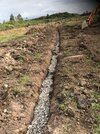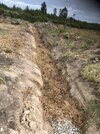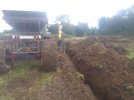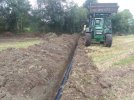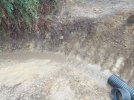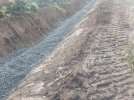You are using an out of date browser. It may not display this or other websites correctly.
You should upgrade or use an alternative browser.
You should upgrade or use an alternative browser.
Drainage
- Thread starter rodders
- Start date
jf 850
Well-Known Member
Doing a bit ourselves these days.
2 inch stone covered with straw, no pipe onless it’s a main shore.
Lovely job . Nice tidy bucket , not too hungry.
Pooles? Seamus Ryan stone here .
It must be soil dependant, I have only drained proper blue clay and the pipes work superbly in that ground filled with 2"round below and above, covered with soil. This is ground right by the estuary with BOW drains and pumping stations. There are land drains drains put in when the grants were around in the 80's in identical ground working away perfectly to this day, 4 inch ones by the looks of it with a constant flow all year around. We only replaced ones where the fall wasn't right in the pipesNothing better than plastic pipe to quickly take a large volume of water away from a source such as a spring. I would never drain without piping.
Barrowsider
Well-Known Member
We have put in pipes without any fall and they're working fine. They must be down deep and laid carefully without any humps or hollows. Once the water table rises to the level of the pipe it takes the path of least resistance and out. Obviously a fall is preferable but better deep and level than shallow with a strong fall.It must be soil dependant, I have only drained proper blue clay and the pipes work superbly in that ground filled with 2"round below and above, covered with soil. This is ground right by the estuary with BOW drains and pumping stations. There are land drains drains put in when the grants were around in the 80's in identical ground working away perfectly to this day, 4 inch ones by the looks of it with a constant flow all year around. We only replaced ones where the fall wasn't right in the pipes
Barrowsider
Well-Known Member
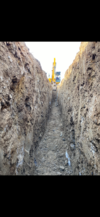
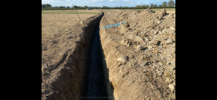
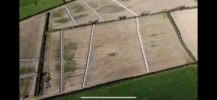

We drained a lump of ground last September. Got a diviner in to locate springs and pulled drains through the areas he suggested. 1.3km of 4" pipe and lots of 2" round stone. Drains buried to between 5 and 8 foot. Very little fall, no fall in some of the drains. We hit no water, the water table was low at the time but we hit layers of permeable gravel in some of the deeper spots which is always encouraging. Took ariel snaps of drains for future reference. We had given up growing winter barley in that land years ago as the roots spent too much of the winter sitting in standing water. The final photo was taken this morning. Great satisfaction in a successful drainage job.
Crops
Well-Known Member
Drainage time of the year again.
Out to catch a few more springs. This 30ac is relatively new to us and we’ve put a lot of money into drains here over the past couple of years.
What we have done so far has transformed the place but we had left some areas until this year.
It’s interesting; the land has a deep clay subsoil and is 1.5 km from the coast. Silty topsoil with virtually no stones present.
It had been in grass with a portion tilled on occasion. The first year, the winter barley was very poor there. Last year it grew 4tn of spring barley and this year it produced 2.1tn of WOSR.
P, K and lime have been corrected.
There’s a hill behind it which leads to springs in our land. It doesn’t appear that a huge effort was ever made to trap the springs.
The drains are being dug 6-8ft deep and we have found veins of gravel running through the clay subsoil. The water from the high ground seems to run through the gravel and then when it meets an end of the gravel it comes to the surface.
We walked the land in the depth of winter and marked the wet spots with painted concrete blocks. Once the crop was cut, we found the blocks and put down marking poles for the digger.
There’s a smell of the sea from the gravel veins when they are opened to the air, this is a hint of their origin.
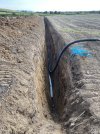
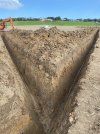
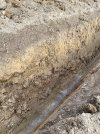
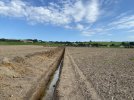
Out to catch a few more springs. This 30ac is relatively new to us and we’ve put a lot of money into drains here over the past couple of years.
What we have done so far has transformed the place but we had left some areas until this year.
It’s interesting; the land has a deep clay subsoil and is 1.5 km from the coast. Silty topsoil with virtually no stones present.
It had been in grass with a portion tilled on occasion. The first year, the winter barley was very poor there. Last year it grew 4tn of spring barley and this year it produced 2.1tn of WOSR.
P, K and lime have been corrected.
There’s a hill behind it which leads to springs in our land. It doesn’t appear that a huge effort was ever made to trap the springs.
The drains are being dug 6-8ft deep and we have found veins of gravel running through the clay subsoil. The water from the high ground seems to run through the gravel and then when it meets an end of the gravel it comes to the surface.
We walked the land in the depth of winter and marked the wet spots with painted concrete blocks. Once the crop was cut, we found the blocks and put down marking poles for the digger.
There’s a smell of the sea from the gravel veins when they are opened to the air, this is a hint of their origin.




Seedsower
Well-Known Member
That's some depth of subsoil,great work being done.we would get a diviner to find the location and direction of the springs then pipe them away.where the water is boiling up is not necessarily where it's coming from.usually 6 to 8ft deep finds the spring boiling up in gravel and pipe it away through the poorer soil that it could not flow through,which is what causes the wet spots.
We have gone deeper in places but usually it gets shallower nearer to the drains.
The laser level made things much easier and more definite to plan
We have gone deeper in places but usually it gets shallower nearer to the drains.
The laser level made things much easier and more definite to plan

